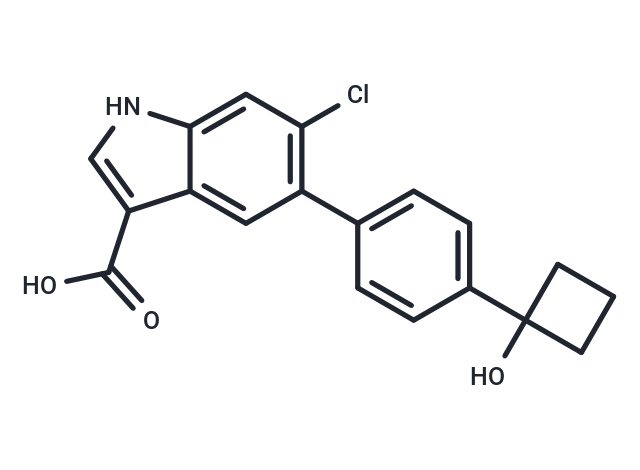Shopping Cart
- Remove All
 Your shopping cart is currently empty
Your shopping cart is currently empty

PF-06409577 is an effective, orally active, and specific allosteric activator of AMPK (EC50: 7 nM, for α1β1γ1).

| Pack Size | Price | Availability | Quantity |
|---|---|---|---|
| 2 mg | $38 | In Stock | |
| 5 mg | $61 | In Stock | |
| 10 mg | $107 | In Stock | |
| 25 mg | $222 | In Stock | |
| 50 mg | $402 | In Stock | |
| 100 mg | $598 | In Stock | |
| 500 mg | $1,290 | In Stock | |
| 1 mL x 10 mM (in DMSO) | $68 | In Stock |
| Description | PF-06409577 is an effective, orally active, and specific allosteric activator of AMPK (EC50: 7 nM, for α1β1γ1). |
| Targets&IC50 | AMPK α1β1γ1:7 nM (EC50) |
| In vitro | In human and rat , PF-06409577 has similar effectiveness for α1β1γ1 isoforms. PF-06409577 exhibits minimal off-target effects on a panel of receptors, ion channels, PDEs, and kinases. PF-06409577 has no inhibition of hERG in a patch-clamp assay (100 μM) and is not an inhibitor (IC50>100 μM) of the microsomal activities of major human cytochrome P450 isoforms[1]. |
| In vivo | In rats, monkeys, and dogs, PF-06409577 has moderate plasma clearance and is well distributed with steady-state distribution volume. Following oral administration of crystalline PF-06409577 in 0.5% methylcellulose suspension, PF-06409577 is rapidly absorbed in dogs, rats, and monkeys. The corresponding oral bioavailability values in rats, monkeys, and dogs are 15%, 59%, and 100%, respectively. Dose-dependent increases in pAMPK relative to total AMPK (tAMPK) in whole kidney tissue are observed with a maximal 3.8-fold response at 300 mg/kg PF-06409577 treatment[1]. Oral administration of PF-06409577 (10, 30, and 100 mg/kg every day) resulted in dose-dependent reductions in proteinuria in the obese ZSF1 animals, with greater than 2-fold reduction in 24-hour urinary albumin loss compared with vehicle control after 60 days of treatment [2]. |
| Kinase Assay | PF-06409577 is prepared in DMSO. PF-06409577 is incubated with fully phosphorylated AMPK in assay buffer at room temperature for 15 min followed by addition of PP2a and another incubation for 60 min at room temperature. The phosphatase treatment is quenched and the kinase assay initiated with the addition of okadaic acid (50 nM final), 50 nM Cy-5 SAMS peptide and ATP equal to Km for each isoform. Reactions are incubated for an additional 60 min and the kinase reaction is quenched with the addition of 10 mM EDTA and 2 nM Eu-pACC antibody in detection Buffer. Kinase activity is monitored by excitation at 320 nM and measuring emission at 665 and 615 nM, respectively[2]. |
| Animal Research | PF-06409577 is prepared in 0.5% methylcellulose[2].Daily administration of 0.5% methylcellulose (p.o.), PF-06409577 at 10, 30, or 100 mg/kg (p.o.), PF- 249 at 3, 10, or 30 mg/kg (p.o.), or ramipril in drinking water (1 mg/kg/day) is initiated and continued for 68 days. Urine is collected for 24-hours and volume recorded from all lean and obese rats after 14, 28, 42, and 60 days of dosing. On Day 63 all rats are administered a final dose after 16-hour overnight fasting. One hour following the final dose, blood glucose is measured by glucometer and a 100 μL tail vein blood sample collected and processed for determination of insulin levels and total protein. Each rat is then anesthetized with isoflurane. The right kidney is collected and immediately freeze-clamped and transferred to liquid nitrogen storage; the left kidney is fixed in 10% formalin. Rats are then euthanized by exsanguination from the vena cava[2]. |
| Alias | PF 06409577 |
| Molecular Weight | 341.79 |
| Formula | C19H16ClNO3 |
| Cas No. | 1467057-23-3 |
| Smiles | OC(=O)c1c[nH]c2cc(Cl)c(cc12)-c1ccc(cc1)C1(O)CCC1 |
| Relative Density. | 1.468 g/cm3 (Predicted) |
| Storage | Powder: -20°C for 3 years | In solvent: -80°C for 1 year | Shipping with blue ice. | ||||||||||||||||||||||||||||||||||||||||
| Solubility Information | Ethanol: 6.8 mg/mL (19.9 mM), Sonication is recommended. DMSO: 55 mg/mL (160.92 mM), Sonication is recommended. H2O: Insoluble | ||||||||||||||||||||||||||||||||||||||||
Solution Preparation Table | |||||||||||||||||||||||||||||||||||||||||
Ethanol/DMSO
DMSO
| |||||||||||||||||||||||||||||||||||||||||

Copyright © 2015-2025 TargetMol Chemicals Inc. All Rights Reserved.